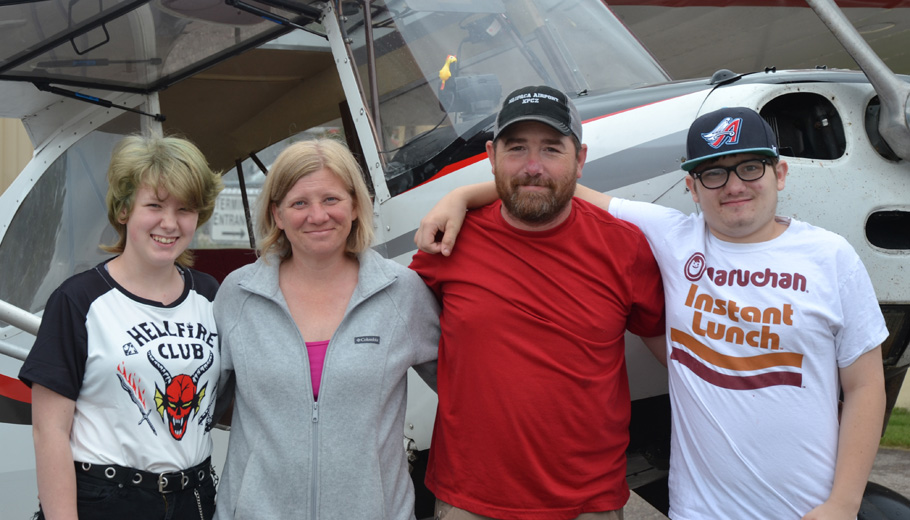
KlattAero keeps a dying art alive in Waupaca
By James Card
The husband-and-wife team of Mat and Britney Klatt are the new managers of the Waupaca Municipal Airport.
They own KlattAero, a family-run aviation company, that has been responsible for the airport’s day-to-day operations since May 1 when Beth Christiansen retired.
They initiated some small changes to make the airport a better place for local and visiting pilots.
One was to make camping available at the airport during the week of EAA AirVenture, the annual air show in Oshkosh. City council approved the idea and if it works out, camping may be available for other events.
They instituted a new fuel program for local pilots. By using fuel cards, they get a 12 cents-per-gallon discount on fuel which ends up being no cost to the city – the savings comes by eliminating credit card fees from the transaction.
Klatt has also leveraged ties to the city with more communication as it can seem like the airport is an island on the outskirts of town. When sand and gravel were building up on the runway, he requested a street sweeper to clean the tarmac.
A few days later, a street sweeper had the runways cleared in a morning.
The second annual drive-in movie organized by the Park & Rec department was a hit: 117 cars lined up to watch a couple free movies.
“I want to work with more community events even if it doesn’t have anything to do with learning to fly or renting an airplane – just as long as it benefits the community. Being at the end of a dead-end road, it’s hard to get new people out here,” said Klatt.
Klatt worked with Jerod Rachu, the city’s community and economic development director, to revise some zoning codes that required airplane hangers to have decorative stonework and other cosmetic requirements. Only one hanger was built in the past decade because of the cost-prohibitive ordnance.
Now, simple, unadorned hangers can be built. Another revision was to allow aviation companies to put a sign on their business. It was not allowed before.
Mastering a craft
Originally from Manawa, Klatt was interested in airplanes as a kid and later in the Navy he worked on aircraft.
He earned his private pilot’s license at the Waupaca airport in 2007. After a short stint as the technical director of two aviation magazines, he was laid off and pondering his next move.
Then an old acquaintance contacted him, asking Klatt if he wanted to restore an old airplane.
The type of restoration was replacing the fabric that covered the framework of the plane. Civilian planes from the 1940s were made of Sitka spruce and covered with fabric. Aluminum was saved for the war effort during WWII. The fabric on these planes eventually needs to be replaced and that is where Klatt found his calling.
“It’s a dying art. It wasn’t the mechanics that I fell in love with; it was the art of it. When it was complete and you step back and looked at it, you had created something. It was different than unbolting a part and bolting on a new part” said Klatt.
“I’m very hands on with it. I like working with the fabric,” said his wife Britney, who has been his partner in learning this craft.
Before the first plane was complete, another restoration was lined up. He earned his A&P certificate through years of on-the-job training. It allows him to perform maintenance work on aircraft without supervision.
While they were working out of a rented hangar at the Waupaca airport, more orders came in.
“We suddenly had our whole year full of restorations. We weren’t posting ads for work anymore. I asked my wife, ‘When was the last time we posted an ad for work?’ and it had been two years. I’ve had jobs everywhere from Connecticut to Kansas to Oklahoma,” said Klatt.
Klatt not only works with the fabric but also sometimes rebuilds the entire frame, which requires precision woodworking skills. Some of the spruce lumber he works with can cost $1,000.
The fabric doesn’t harden. It stays flexible but it is tight as a drum.
“I would akin it to aluminum airplanes are like turtles or a bugs and these are more like a human. The skeleton is inside providing the strength and the fabric is just a skin, whereas with an aluminum airplane, the strength is the skin,” he said.
Longtime aircraft mechanic Richard Merkley died in 2020. There is a memorial bench at the airport with his name. He was a friend and mentor to Klatt. His passing left nobody to perform aircraft inspections at the airport – an essential service in the aviation world.
Klatt worked to earn his Inspection Authorization certification so he could provide the service to local and incoming pilots. He also expanded his business to perform general maintenance and avionics work on planes – everything from engine to oil changes.
